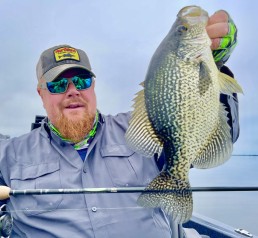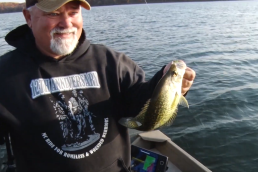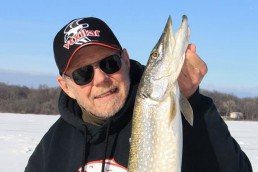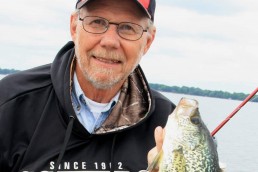SHARE THIS POST
Midsummer is usually consistent with warmer waters, which means vegetation grows tall and acres of weed beds fill in. Of course, every summer, weather patterns are slightly different. But the last several years, we have had 60- to 70-degree waters for a longer duration of time.
Why does this matter? In northern Minnesota, weeds fill with life. Every fish species swims in and around weed growth while minnows and insects hide in thicker weed areas. I have always considered vegetation my primary go-to when guiding, not just for walleyes, but also for catching slab crappies and bluegills. Heat creates a perfect weed habitat and speeds up the metabolism in panfish. Big ‘gills and crappies don’t just look and swim away; they bite!
The forage web through spawn
Panfish primarily eat insects year-round. The summer hatches of midge flies, mayflies, stoneflies and dragonfly nymphs keep panfish well fed. Along with insects, crappies pluck minnows from the water column. Bluegills are known to primarily be insect eaters, but in midsummer, bluegills will eat small young-of-the-year minnows—which means they’re more aggressive and ready to chase prey.
Bluegills spawn when the water temperature is in the 70s, which makes them a summer spawner. Depending on the water temperatures, bluegills may nest into July in northern Minnesota. During years when the water is cooler, bluegills won’t spawn, and reabsorb their eggs. Some years, they spawn just before midsummer and then dump out a little deeper. The males linger to protect the nest.
Larger ‘gills spawn deeper than the rest. Instead of 3 or 4 feet, they will spawn in 5 feet, even up to 10 feet, in hard-bottom areas on clear lakes with tall emergent weeds. Big bluegills dump out of the spawning areas faster than smaller bluegills. While crappies have already spawned and are more concerned with feeding, both crappies and bluegills need the same thing: green weeds.
“Craning” in weeds
Vegetation creates a different approach to fishing panfish, from the emergent vegetation (bulrushes) to submergent (cabbage and watermilfoil). Finding and hooking a crappie or bluegill in tall weeds can lead to weed tangles when anglers fight fish to the boat. Bluegills turn and spin in a circle, which can wrap your line around the stalk. Crappies dive and get buried. Pulling too hard will tear the fragile membrane of their lips, allowing them to escape.
I use longer rods in midsummer, like 7- to 8-foot St. Croix Avid Panfish Series rods, and vertically set my baits down into pockets in the weeds. I use a Light Bite bobber and a Northland Tungsten Feather Jig tipped with a minnow, chunk of ‘crawler or a tiny leech. If I don’t get bit within 30 seconds to one minute, I lift and drop into another pocket, like a mini-crane operator. When hooking a fish, set the hook gently by reeling in, along with a slight sweep of the rod tip. Fight the fish straight up. Keeping it close to the boat allows me to fight the fish over the top and not through a maze of obstacles.
Found: needles in a haystack!
Finding panfish in massive acreages of weeds reminds me of a corn maze on a giant farm. The lakes I fish run from 500 to over 100,000 acres, which can be overwhelming. I use my Humminbird HELIX LakeMaster map to shade the 4- to 10-foot depths in a green highlight. This is the food shelf (weed bed), narrowing down the target from giant to small. Side imaging allows you to see the end of the weeds, pockets and points, providing detail of the outside edge of weed growth and unique shapes. Stop and fish the different edges.
Keep an eye on water temperature. If it’s over 73 degrees, start on the outside of the weed bed, by the outer weed line. If it is under 73 degrees, fish shallow to deep. However, not every lake is the same. Some lakes have intermittent vegetation. Some have darker water and shallow vegetation. Super-clear lakes will continue to grow vegetation even in the 20-foot range and deeper.
If vegetation starts dying or decaying, crappies and bluegills will move to the outside of vegetation or to rock structures and humps with sharp breaks. They need some way to hide from predators. This is why panfish are always creatures of edges.
Are you enjoying this post?
You can be among the first to get the latest info on where to go, what to use and how to use it!
When you find fish, it will usually be a mix of crappies and bluegills in the same pockets. Bass, walleyes and northern pike are an added bonus—and give you a true battle on panfish gear!
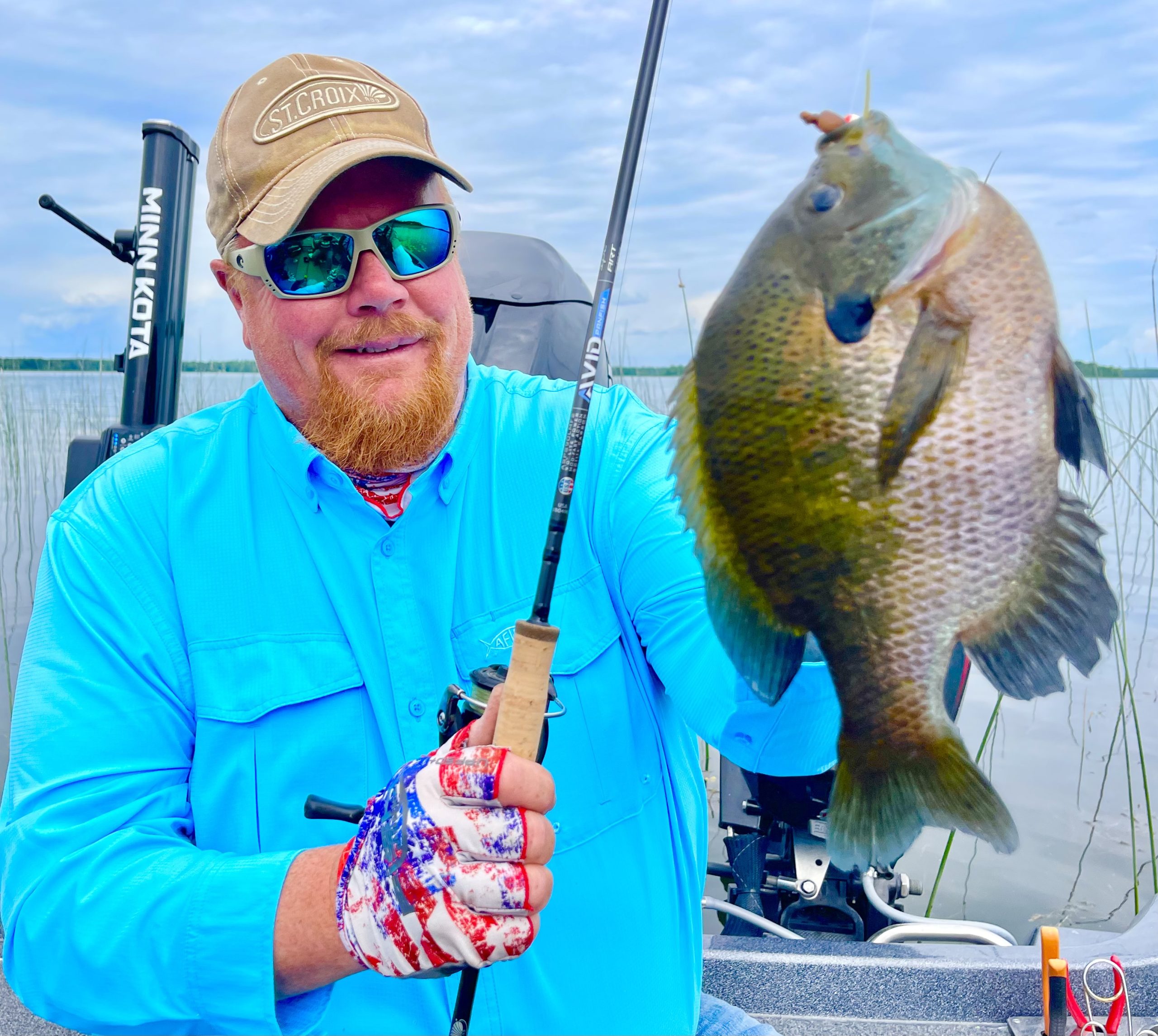
Suspended crappies and bluegills
As late summer approaches, panfish move out of the weeds to slightly off the edge, and then suspend. I have noticed this in countless lakes. This is barren wasteland—no weeds, no structure, just a slow, gentle slide to the deepest part of the lake. They choose to linger in this zone before dumping to deeper depths in the fall. Most of the food is still on the edge of the weeds; they are gleaning insects and minnows as they leave the weed beds. Both crappies and bluegills are reluctant to drop into deeper water until fall turnover arrives.
During late summer, fish are easier to mark on side imaging. If you have MEGA Live forward viewing, you can see the fish by waving the down rod back and forth or driving your boat forward with the down rod looking slightly forward, to see fish in the distance. Stop when they are behind the boat 30 to 40 feet, hit Spot-Lock on your trolling motor and pitch back to them.
Panfish stealth rig
Drop-shots began with bass fishing and started catching walleyes after we realized the fish were suspended off the bottom, revealed with forward viewing. It works extremely well with panfish, allowing you to tie a hook on your drop-shot rig at the level of the fish. This is especially deadly in summer.
With slip bobbers, everything works until the wind blows. If the wind blows, your bobber drifts away from the fish, keeping you out of the target zone most of the time, especially as water depths increase. Drop-shots put the bait at the level of the fish while the sinker is on the bottom. This keeps your presentation in the right spot—right in front of the fish—without any trouble from the wind.
I use a #4 Gamakatsu drop-shot hook. Or I tie a finger-length of line around two to three inches off a drop-shot knot, and then add a #4 or smaller #6 hook with a colorful plastic tail and waxworm or minnow, incorporating a tungsten weight at the bottom of the rig. If the panfish are 6 feet off the bottom, put the hook 6 feet above the sinker. You will be in the strike zone all the time, no matter how windy it is.
This may sound complicated, but it’s much easier than using a slip bobber. Casting is the catch. Use a longer rod if the fish are suspended off the bottom. Cast out and reel the presentation up to the fish. If they don’t bite, swim it by them. The best thing about drop-shot-style rigs is that you can stop and jig the rod tip, moving the bait without dislodging the sinker from the bottom.
Good hunting
For comparison, in the world of deer hunting, a hunter walks the whole woods before choosing a spot. In fishing, we must do the same. With modern day electronics such as mapping, sonar, side imaging and forward viewing, we can study before we take the test of angling. Remember, in a lake full of weeds, you need to fish by craning, dropping and plunking weed pockets. The element of surprise is a bent rod on a drop in a weed pocket, leading to a diving crappie or spinning bluegill.
Good luck dropping in on panfish this summer!
MWO
SHARE THIS POST
Did you enjoy this post?
You can be among the first to get the latest info on where to go, what to use and how to use it!
Brian 'Bro' Brosdahl
Outdoor communicator Brian “Bro” Brosdahl lives in northern Minnesota. He is a walleye guide in the Cass Lake, Leech Lake and Lake Winnibigoshish areas. He is sponsored by Northland Fishing Tackle, Frabill/Plano, Aqua-Vu, Humminbird/Minn Kota, St. Croix Rods, Ranger Boats, and Evinrude. Guide inquiries: brosguideservice.com. Follow on social media.
